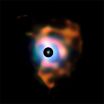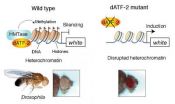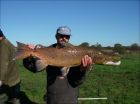(Press-News.org) Betelgeuse, a red supergiant in the constellation of Orion, is one of the brightest stars in the night sky. It is also one of the biggest, being almost the size of the orbit of Jupiter — about four and half times the diameter of the Earth's orbit. The VLT image shows the surrounding nebula, which is much bigger than the supergiant itself, stretching 60 billion kilometres away from the star's surface — about 400 times the distance of the Earth from the Sun.
Red supergiants like Betelgeuse represent one of the last stages in the life of a massive star. In this short-lived phase, the star increases in size, and expels material into space at a tremendous rate — it sheds immense quantities of material (about the mass of the Sun) in just 10 000 years.
The process by which material is shed from a star like Betelgeuse involves two phenomena. The first is the formation of huge plumes of gas (although much smaller than the nebula now imaged) extending into space from the star's surface, previously detected using the NACO instrument on the VLT [1]. The other, which is behind the ejection of the plumes, is the vigorous up and down movement of giant bubbles in Betelgeuse's atmosphere — like boiling water circulating in a pot (eso0927 - http://www.eso.org/public/news/eso0927/).
The new results show that the plumes seen close to the star are probably connected to structures in the outer nebula now imaged in the infrared with VISIR. The nebula cannot be seen in visible light, as the very bright Betelgeuse completely outshines it. The irregular, asymmetric shape of the material indicates that the star did not eject its material in a symmetric way. The bubbles of stellar material and the giant plumes they originate may be responsible for the clumpy look of the nebula.
The material visible in the new image is most likely made of silicate and alumina dust. This is the same material that forms most of the crust of the Earth and other rocky planets. At some time in the distant past, the silicates of the Earth were formed by a massive (and now extinct) star similar to Betelgeuse.
In this composite image, the earlier NACO observations of the plumes are reproduced in the central disc. The small red circle in the middle has a diameter about four and half times that of the Earth's orbit and represents the location of Betelgeuse's visible surface. The black disc corresponds to a very bright part of the image that was masked to allow the fainter nebula to be seen. The VISIR images were taken through infrared filters sensitive to radiation of different wavelengths, with blue corresponding to shorter wavelengths and red to longer. The field of view is 5.63 x 5.63 arcseconds.
INFORMATION:
Notes
[1] NACO is a VLT instrument that combines the Nasmyth Adaptive Optics System (NAOS) and the Near-infrared Imager and Spectrograph (CONICA). It provides adaptive optics assisted imaging, imaging polarimetry, coronography and spectroscopy, at near-infrared wavelengths.
More information
This research was presented in a paper to appear in the journal Astronomy & Astrophysics.
The team is composed of P. Kervella (Observatoire de Paris, France), G. Perrin (Observatoire de Paris, France), A. Chiavassa (Universite Libre de Bruxelles, Belgium), S. T. Ridgway (National Optical Astronomy Observatories, Tucson, USA), J. Cami (University of Western Ontario,Canada; SETI Institute, Mountain View, USA), X. Haubois (Universidade de Sao Paulo, Brazil) and T. Verhoelst (Instituut voor Sterrenkunde, Leuven, Belgium).
ESO, the European Southern Observatory, is the foremost intergovernmental astronomy organisation in Europe and the world's most productive astronomical observatory. It is supported by 15 countries: Austria, Belgium, Brazil, the Czech Republic, Denmark, France, Finland, Germany, Italy, the Netherlands, Portugal, Spain, Sweden, Switzerland and the United Kingdom. ESO carries out an ambitious programme focused on the design, construction and operation of powerful ground-based observing facilities enabling astronomers to make important scientific discoveries. ESO also plays a leading role in promoting and organising cooperation in astronomical research. ESO operates three unique world-class observing sites in Chile: La Silla, Paranal and Chajnantor. At Paranal, ESO operates the Very Large Telescope, the world's most advanced visible-light astronomical observatory and two survey telescopes. VISTA works in the infrared and is the world's largest survey telescope and the VLT Survey Telescope is the largest telescope designed to exclusively survey the skies in visible light. ESO is the European partner of a revolutionary astronomical telescope ALMA, the largest astronomical project in existence. ESO is currently planning a 40-metre-class European Extremely Large optical/near-infrared Telescope, the E-ELT, which will become "the world's biggest eye on the sky".
Links
Research paper:
http://www.eso.org/public/archives/releases/sciencepapers/eso1121/eso1121.pdf
Photos of the VLT:
http://www.eso.org/public/images/archive/category/paranal/
Contacts
Pierre Kervella
LESIA, Observatoire de Paris,
CNRS, Université Pierre et Marie Curie,
Université Denis Diderot
Paris, France
Tel: +33 1 45 07 79 66
Email: Pierre.Kervella@obspm.fr
Guy Perrin
LESIA, Observatoire de Paris,
CNRS, Université Pierre et Marie Curie,
Université Denis Diderot
Paris, France
Tel: +33 1 45 07 79 63
Email: guy.perrin@obspm.fr
Richard Hook
ESO, La Silla, Paranal, E-ELT and Survey Telescopes Public Information Officer
Garching bei München, Germany
Tel: +49 89 3200 6655
Email: rhook@eso.org
The flames of Betelgeuse
New image reveals vast nebula around famous supergiant star
2011-06-24
ELSE PRESS RELEASES FROM THIS DATE:
Mechanism for stress-induced epigenetic inheritance uncovered in new study
2011-06-24
Researchers at RIKEN have uncovered a mechanism by which the effects of stress in the fly species Drosophila are inherited epigenetically over many generations through changes to the structure of chromatin, the material that makes up the cell nucleus. Published in the journal Cell, the results highlight the role of the transcription factor dATF-2 in chromatin assembly, marking a major advance in our understanding of non-Mendelian inheritance.
Recent years have seen growing interest in the phenomenon of epigenetic inheritance: the idea that our genome, through epigenetic ...
Senators Latest Target: Smartphone DUI Apps
2011-06-24
An app created by the Canadian based creators of Blackberry, Research In Motion, has recently been pulled off the company's online store after a formal request from four U.S. Senators.
Known as the "DUI app," it allows users to pinpoint the exact locations of local police checkpoints using GPS. The apps also locate traffic cameras and speed traps.
Web applications like these, however, are gaining widespread attention by law enforcement and legislative officials across the country.
Senators Harry Reid, D-Nevada; Charles Schumer, D-New York; Frank Lautenberg, ...
Oxytocin promises hope in Prader-Willi syndrome
2011-06-24
Prader-Willi syndrome is a rare genetic disorder which affects one child in 25,000. Children born with this syndrome have a range of complex neurological and developmental problems which continue into adult life. These can manifest as cognitive and behavioral difficulties, weight gain, problems in controlling their temper and attendant difficulties in socialization. New research published in BioMed Central's open access journal Orphanet Journal of Rare Diseases, demonstrates that the hormone oxytocin is able to positively affect patients by improving trust, mood, and reducing ...
Synthetic collagen from maize has human properties
2011-06-24
Synthetic collagen has a wide range of applications in reconstructive and cosmetic surgery and in the food industry. For proper function in animals a certain number of prolines within the protein need to be hydroxylated. BioMed Central's open access journal BMC Biotechnology reports that for the first time the α1 chain of type 1 collagen has been produced in maize with similar levels of proline hydroxylation to human collagen.
Most collagen used is derived from animals but there are risks associated with this collagen containing infectious agents or being rejected ...
A thermometer for dinosaurs
2011-06-24
Small heads, large bodies, and a slow metabolism -- these are the characteristics that make us think of dinosaurs as dull, lethargic and cold-blooded giants. However, this image seems to be deceiving. These giant saurians that have been extinct for 65 million years may have been high-performance models of evolution. In cooperation with colleagues from the US, researchers from the University of Bonn have just determined that the body temperature of some large herbivorous dinosaurs was between 36 and 38 degrees Celsius. "Originally, dinosaurs were considered to have been ...
Discovering lost salmon at sea
2011-06-24
Where Atlantic salmon feed in the ocean has been a long-standing mystery, but new research led by the University of Southampton shows that marine location can be recovered from the chemistry of fish scales. Surprisingly, salmon from different British rivers migrate to feed in separate places, and may respond differently to environmental change.
Numbers of Atlantic salmon have declined across their range since the early 1970s, and most researchers believe that conditions experienced at sea are largely to blame. Unfortunately, identifying where salmon go to feed in the ...
Parenting Time Plans in Oregon
2011-06-24
Oregon law requires that a parenting time plan be included in all judgments where minor children are involved.
In Oregon, "parenting time" (called "visitation" in some states) is the scheduled time that each parent has with the children. The parenting time plan is a document that states when the children will be with each parent and how decisions will be made for the parties' children.
The amount of parenting time that each parent has with the children is not necessarily related to whether or not a parent has legal custody in Oregon. In Oregon, ...
Building a better math teacher
2011-06-24
For years, it has been assumed that teachers—specifically math teachers—need to master the content they intend to teach. And the best way to do this is to take courses beyond that content.
Yet in a paper published today in the Education Forum of the journal Science, Dr. Brent Davis of the University of Calgary says research does not support this common belief. There is little evidence that advanced courses in mathematics contribute to more effective teaching.
"You know that feeling, when you try to explain to a child how to add multi-digit numbers, and you realize that ...
Ghrelin likely involved in why we choose 'comfort foods' when stressed
2011-06-24
DALLAS – June 23, 2011 – We are one step closer to deciphering why some stressed people indulge in chocolate, mashed potatoes, ice cream and other high-calorie, high-fat comfort foods.
UT Southwestern Medical Center-led findings, in a mouse study, suggest that ghrelin – the so-called "hunger hormone" – is involved in triggering this reaction to high stress situations.
"This helps explain certain complex eating behaviors and may be one of the mechanisms by which obesity develops in people exposed to psychosocial stress," said Dr. Jeffrey Zigman, assistant professor ...
Ovenbirds eavesdrop on chipmunks to protect nests
2011-06-24
Ground-nesting birds face an uphill struggle to successfully rear their young, many eggs and fledglings falling prey to predators. Now, scientists from the USA have found that some birds eavesdrop on their enemies, using this information to find safer spots to build their nests. The study – one of the first of its kind – is published this week in the British Ecological Society's Journal of Animal Ecology.
Ovenbirds and veeries both build their nests on the ground, running the risk of losing their eggs or chicks to neighbouring chipmunks. Nesting birds use a range of cues ...
LAST 30 PRESS RELEASES:
Tracing the quick synthesis of an industrially important catalyst
New software sheds light on cancer’s hidden genetic networks
UT Health San Antonio awarded $3 million in CPRIT grants to bolster cancer research and prevention efforts in South Texas
Third symposium spotlights global challenge of new contaminants in China’s fight against pollution
From straw to soil harmony: International team reveals how biochar supercharges carbon-smart farming
Myeloma: How AI is redrawing the map of cancer care
Manhattan E. Charurat, Ph.D., MHS invested as the Homer and Martha Gudelsky Distinguished Professor in Medicine at the University of Maryland School of Medicine
Insilico Medicine’s Pharma.AI Q4 Winter Launch Recap: Revolutionizing drug discovery with cutting-edge AI innovations, accelerating the path to pharmaceutical superintelligence
Nanoplastics have diet-dependent impacts on digestive system health
Brain neuron death occurs throughout life and increases with age, a natural human protein drug may halt neuron death in Alzheimer’s disease
SPIE and CLP announce the recipients of the 2025 Advanced Photonics Young Innovator Award
Lessons from the Caldor Fire’s Christmas Valley ‘Miracle’
Ant societies rose by trading individual protection for collective power
Research reveals how ancient viral DNA shapes early embryonic development
A molecular gatekeeper that controls protein synthesis
New ‘cloaking device’ concept to shield sensitive tech from magnetic fields
Researchers show impact of mountain building and climate change on alpine biodiversity
Study models the transition from Neanderthals to modern humans in Europe
University of Phoenix College of Doctoral Studies releases white paper on AI-driven skilling to reduce burnout and restore worker autonomy
AIs fail at the game of visual “telephone”
The levers for a sustainable food system
Potential changes in US homelessness by ending federal support for housing first programs
Vulnerability of large language models to prompt injection when providing medical advice
Researchers develop new system for high-energy-density, long-life, multi-electron transfer bromine-based flow batteries
Ending federal support for housing first programs could increase U.S. homelessness by 5% in one year, new JAMA study finds
New research uncovers molecular ‘safety switch’ shielding cancers from immune attack
Bacteria resisting viral infection can still sink carbon to ocean floor
Younger biological age may increase depression risk in older women during COVID-19
Bharat Innovates 2026 National Basecamp Showcases India’s Most Promising Deep-Tech Ventures
Here’s what determines whether your income level rises or falls
[Press-News.org] The flames of BetelgeuseNew image reveals vast nebula around famous supergiant star



